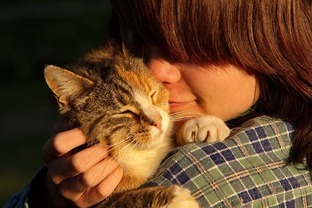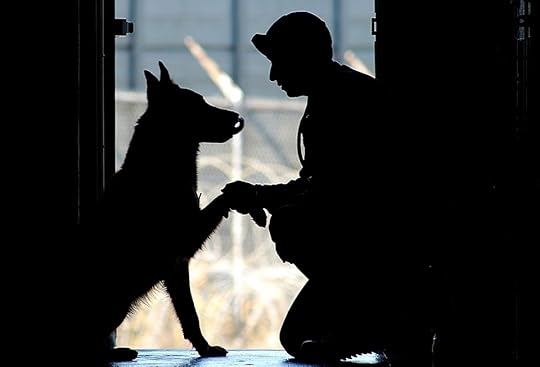Gayle Irwin's Blog, page 24
December 6, 2016
Christmas Gifts for Furry Family Members
 For many people, pets are family, and when the holiday season rolls around, they purchase Christmas gifts for their furry companions. So, what gifts can you give your furry family members? Here are four ideas:
For many people, pets are family, and when the holiday season rolls around, they purchase Christmas gifts for their furry companions. So, what gifts can you give your furry family members? Here are four ideas:Toys – from rubber balls and Kong® toys to catnip mice and hamster wheels, there are a variety of toys for pets and the various species of animals that reside in homes.Clothing – many pet parents purchase clothing items for their furry family members, such as sweaters, coats, boots, dresses, and bowties. Smaller dogs can get chilled easily during inclement weather, therefore coats and sweaters are not a stretch, and boots protect animals’ feet from ice and poisons such as antifreeze.Treats – cats and dogs, rabbits and birds, all enjoy a tasty treat now and then, just like people. Ask your veterinarian or the local pet supply store manager for ideas if the task appears overwhelming (and there is truly a plethora of treat options!) or if your animal has food allergies or is elderly.Beds and Blankets – a soft, cushy bed helps a pet stay warm during the cold, winter months. Beds also help animals who suffer from arthritis, and a soft blanket on the couch keeps both pet and pet parent warm and snuggly together.
“Stockings hung by the chimney with care…” Treats, toys, collars, and other items can be slipped into a stocking for Fido and Fluffy just like candy is given to human children. Even wrapped gifts, like sweaters, beds, books, or large rawhide bones, can be found under Christmas trees with the pet’s name on the gift tag. I had a dog more than 20 years ago who loved tearing into his Christmas present under the tree – it was fun to watch him “open” his special gift!
A recent article in Woman's Day provided gift ideas under $50 for the pet in your life. Read the article by clicking on this link: http://www.womansday.com/life/pet-care/g946/pet-gifts/.
Most pet-lovers I know give their furry friends Christmas gifts (some also provide birthday presents and parties for their special fur-balls) -- how about you? Do you give gifts to your animals during the holiday season?

Published on December 06, 2016 05:00
November 29, 2016
10 Ways to Keep Your Pets Warm and Safe During Winter
 Although autumn has lasted much longer in the Rocky Mountain states than usual, including some highs in the 50s during Thanksgiving, we all know winter is on its way – and in some places has already blasted in. The cold season brings potentially harmful issues for our pets, from frostbite to poisoning.
Although autumn has lasted much longer in the Rocky Mountain states than usual, including some highs in the 50s during Thanksgiving, we all know winter is on its way – and in some places has already blasted in. The cold season brings potentially harmful issues for our pets, from frostbite to poisoning. Below are ten ideas to help keep your pet warmer and safer during the winter months:
Consider coats. Short-haired dog breeds or older animals may need a coat to wear outside while on a walk. No one likes feeling like an icicle, including our beloved pets, so if you have a dog that's affected by colder temperatures, provide an extra layer of warmth in the form of a coat. Also, it's not a good idea to shave your pet to the skin during the winter months – the animal's fur helps insulate it from the harsh winter weather.Buy booties. The pads of a pet's feet can become frost-bitten if they are outdoors for too long. Ice, snow, and icemelt can also be picked up while outside. Many mushers and other dog owners use booties specifically made for dogs to protect their paws; you, too, may find those beneficial for your pet.
Don’t lose it. Dogs shouldn’t run off-leash while outdoors unless in a secured fence, especially during a snowstorm. Dogs often rely on scent to find their way, and they can lose that scent easily in snow and wind. According to the ASPCA (American Society for the Prevention of Cruelty to Animals), more dogs are lost during winter months than other times of the year.Wear updated ID. Make sure your pets have ID tags and/or microchips with current owner information so they can be returned home if they do become lost.Make areas warm. Create a cozy place for your pet to sleep, if they sleep inside the house or in a kennel in the backyard. If you have outdoor animals, provide them with a strong, warm shelter, including straw for inside the barn or doghouse. If your pets live indoors, a snug bed keeps them warmer and is more comfortable than the hard, cold floor.Dry off. When your dog is bathed, make sure he is completely dry before going outdoors.Clean the coat. When returning home from a walk, clean your dog’s paws, legs and stomach area. Your pet can ingest anti-freeze, salt, and other harmful chemicals if he’s allowed to clean himself.Keep pets from poisons. Anti-freeze poisons to pets, so keep your pets away from it. Keep kitty inside. It's best to keep your cat indoors during the winter. Cats can freeze, become lost, or contract a deadly disease such as rabies when outdoors in winter. Additionally, many people feed wild birds during this season, and cats can be deadly on these lovely wild things that others are not only caring for, but also enjoy watching at the feeders.Check the car engine. Cats often climb into the engine compartments of vehicles to stay warm, therefore, prior to starting your car's engine, bang on the hood to scare away any potential stowaways. Fan belts seriously injure, even kill, cats and other small animals that crawl into the engine area. Some even huddle in the wheel-well, so do a thorough check of your car before pulling away.
Putting these guidelines into action will help keep your four-footed companion warmer and safer during these chilly winter months.

Published on November 29, 2016 06:00
November 22, 2016
Need a Sitter for Your Critter? 4 Websites to Find Petsitters
 Whether you’re gone a day, a week, or more, pet parents need reliable people to take care of the furry members of the family. Perhaps a local doggie day care (or kitty care center) is great for the time you’re at work, but what if you must go out of town for business travel? Or you’re taking the kids to Disney World for a week? Or your sweetie to the Bahamas for Valentine’s weekend? To where and whom do you turn for longer times away from home? Who do you trust to take care of your four-legged friends?
Whether you’re gone a day, a week, or more, pet parents need reliable people to take care of the furry members of the family. Perhaps a local doggie day care (or kitty care center) is great for the time you’re at work, but what if you must go out of town for business travel? Or you’re taking the kids to Disney World for a week? Or your sweetie to the Bahamas for Valentine’s weekend? To where and whom do you turn for longer times away from home? Who do you trust to take care of your four-legged friends?Friends can help, but maybe not always and maybe not when you need them… or for as long as you need them. Boarding at the vet’s can work, but if your animals aren’t sick, do they need to be stuck in cages for a week? That’s almost like being at the animal shelter. Perhaps there are other boarding options in your community, like a communal “pet lodge.” But, then again, maybe not anywhere close to you. What are some other options?
Online searches reveal several sources for pet sitting. Here are three:
Rover.com – through this site you can find critter sitters who take care of pets in your house (so also house-sitting) as well as in the sitter’s home. This site comes in handy when you travel with your pet as well – you can find Rover sitters in many large (and small) cities. My husband and I have used this service a few times, in particular when we’ve been to a city and wanted to go out and do things that could take us into the wee hours of the morning (like concerts and ballgames). We have found Rover to be a reputable site and have had great experiences with the three sitters we’ve used; we plan to use a Rover sitter again next summer when we travel.
DogVacay.com – specializing in pet care needs, like Rover.com, this site offers sitter referrals, including boarding, daycare, and walking services. I’ve not used this site or sitter services, but it has been featured on NBC’s Today Show, on CBS, and in several print publications, such as Forbes and USA Today.
Care.com – this site features not only critter sitters, but also nanny services, elder care offerings, and housekeepers as well as errand runners. Although I’ve not used this site, I’ve heard positive things about it and since the site offers many types of caring help, it may be a good one for multiple needs.
SitterCity.com – this site also offers several options, including pet care, elder care, and special needs care. I don't know much about this site either, but I learned it started in 2001 as a Boston-area-focused resource; it has grown significantly to a national service.
Many of these critter sitters will not only feed and water your pet, but also spend quality time with your furry friend, such as walking the dog, taking Fido to the dog park, or playing mouse and feather toys with your kitty. Often the pet parent receives photos of the fun (and rest) the pet is experiencing. It’s always a relief for a pet parent like me to know the four-footed companion is in loving, capable hands.
With the holidays upon us and many people planning their 2017 vacations, now is a good time to consider “who will look after the fur-kids while we’re gone?” Spend time reviewing these sites, consider all your options, and don’t rely on friends’ and families’ good intentions. Pet sitting is a strong enterprise with very reputable and caring people who want to have a small business and who love animals. Consider these services before your next adventure and let Fido or Fluffy have their fun, too – with a good pet sitter.

Published on November 22, 2016 05:30
November 18, 2016
Rover.com Uncovers 3 Misconceptions About Homeless Pets from the People Who Save Them
 Guest Post by Kelly Wright, Rover.com
Guest Post by Kelly Wright, Rover.comThose of us who have had the honor of adding a rescue pet to our families know what incredible creatures they are — and so do the amazing people working in animal rescue who make these connections possible!
Through our conversations with rescue volunteers for our latest feature, Real-life Heroes: Animal Rescue Volunteers Share How They Keep Fighting the Good Fight , the Rover.com team learned that although there are many of us who are advocates of adopting, rescue pets are still often misunderstood. And unfortunately, these misconceptions often prevent loving animals from finding their forever homes.
Here are a few falsehoods rescuers want to clear up about the animals they save:
All kinds of breeds need to be rescued — even purebreds
It is a flat-out myth that there are only mixed or large breeds available for adoption. No matter what kind of critter your heart desires, you’re likely to find one in your local shelter or rescue.
“What we get a lot of is that people want a purebred, or they need a hypoallergenic dog for allergies. We have those in rescues,” said Lisa Jensen, a Board Member of Safe Haven Animal Rescue in Oklahoma City. “In Oklahoma, we have a problem with puppy mills, and we often get the rejects from the mills. Those kids are great dogs, and purebred!”
And if your local rescue doesn’t have what you’re looking for, Lisa said you can still opt to adopt: “Even in the shelters, we have so many purebreds!”
You’re also not limited to rescuing an adult if you have hopes of bringing a puppy or kitten into your home.
“If you are looking for a younger animal, shelters often have puppies and kittens,” said Jessi Burns, Marketing and Communications Manager of Foothills Animal Shelter in Colorado.
They come with ‘built-in’ benefits
Of course, if you are open to adopting an adult or even a senior pet, there are plenty in need of a good home — and it turns out, there are a lot of perks to picking a pet with a little experience under his belt!
“A lot of shelter animals are adults, so what you see is what you get,” Jessi explained. “When you meet them, you can get an idea about their personality, size, and energy level.”
And this can be especially helpful for parents with younger children, and aren’t looking for another “kid” to raise.
“In addition, most have already lived in a home environment, so they know how to behave appropriately and won’t chew on your furniture or go to the bathroom indoors,” Jessi went on.
They’re truly good pets — the rescues do their homework!
It is true that tragically, many of the animals that wind up in shelters or in rescues have had a rough start, and some are a bit more timid than others due to past neglect or even abuse.
But don’t let that stop you from adoption — the volunteers who work in animal rescue put every effort into rehabilitating animals physically and emotionally, and don’t adopt them out until they’re confident they’re ready for their new family.
“Yes, animals with behavior issues do come into rescue, but those animals are placed in experienced foster homes,” Marina Hebert, a volunteer with Small Animal Rescue Society of BC in Vancouver, pointed out.
Many people who foster have years of experience working with special-needs pets, and work with rescues time and again to make sure that these creatures get the time and attention they need before going off to their forever homes.
“The ones rescues put up for adoption have been carefully screened,” explained Marina.
The close relationship fosterers and rescuers share with the pets they care for not only helps ensure that they’re ready to live with a new family, but also that they’ll end up with the perfect people.
“They’ve spent time with volunteers who know all their needs and quirks, and actually know them so they can match them to the right people,” Marina said.
The truth is, every animal deserves a happy life, no matter how they got their start. If you’re interested in adding a new furry — or feather, or scaly, or even hairless! — family member to your brood, consider visiting your local shelter or rescue.
As Jessi told us, not only will you save a life, but you’ll also make an irreplaceable friend. “I truly believe that shelter animals make the most amazing pets and companions!”
Kelly Wright explores and celebrates the magical and mysterious bond between pets and people for Rover.com’s Animal Heroes section. If you have an amazing story about how an animal has brought joy and wonder to your life, please email her at kelly@rover.com.
Published on November 18, 2016 06:30
November 15, 2016
Pet Insurance - Is It Right For You?
 People love their pets, but admittedly, they can cost pet parents a lot of money. According to the American Pet Products Association (APPA), people in the United States spent more than $60 billion dollars on their furry friends in 2015, up $2 billion from the previous year. About 80 million households have pets, with dogs making up the majority of furry friends: more than 54 million. The APPA estimates the average American family spends more than $1,600 on a dog’s vet bills and more than $1,100 on kitty health.
People love their pets, but admittedly, they can cost pet parents a lot of money. According to the American Pet Products Association (APPA), people in the United States spent more than $60 billion dollars on their furry friends in 2015, up $2 billion from the previous year. About 80 million households have pets, with dogs making up the majority of furry friends: more than 54 million. The APPA estimates the average American family spends more than $1,600 on a dog’s vet bills and more than $1,100 on kitty health.According to an article on TheSimpleDollar.com, which references the APPA report, “the costs of veterinary care have risen faster than inflation.” Between medical exams/wellness care, vaccinations, dental procedures, and operations (including spay/neuter), pet health care, like people health care, is a significant expense. Pet insurance may help.
There are several national pet insurance carriers, including the ASPCA (American Society for the Prevention of Cruelty to Animals), Nationwide, Trupanion, PetFirst, HealthyPaws, and PetsBest. Deductibles vary, and some plans reimburse 70 to 90 percent of a veterinary bill. Plan costs vary, depending upon the deductible, coverage, type and age of pet.
But, how does one choose a plan and a company? Luckily for pet parents, some of the research has already been done. Consumer Advocate, for example, ranks companies based on reviews. A person can select their state to see if coverage is available.The Canine Journal has also reviewed and ranked pet insurance companies.
Additionally, The Simple Dollar recently released a guide on pet insurance companies. The author of the report used his own pets as examples in comparing companies and plans.
I’ve never carried health insurance on my pets, but I’ve often considered it. A friend of mine, however, does pay for pet insurance, and she believes having such coverage is a great benefit. She is an individual on a fixed income due to a disability. My friend had a cat who lived to be nearly 17 years of age; that cat became diabetic at about age 12. The added expense of insulin was covered on her pet insurance plan, and as the cat grew older and more health problems developed, she found having pet health insurance a wonderful asset. So, for those of us who don’t carry pet insurance, it may be something to consider. Having resources such as that provided by The Simple Dollar, The Canine Journal, and Consumer Advocate can help pet parents review plans and premiums and decide if pet insurance is something to expend money on.
To insure or not insure is a question to consider no matter what type or age of pet you have.
Published on November 15, 2016 05:00
November 10, 2016
Honoring Two- and Four-Footed Heroes on Veterans Day
 Veterans Day is upon us, a time to honor and thank our military men and women and their families. Without their loyalty to country and their sacrifice, oftentimes to the point of major injury or death, Americans would live with a lot less freedom.
Veterans Day is upon us, a time to honor and thank our military men and women and their families. Without their loyalty to country and their sacrifice, oftentimes to the point of major injury or death, Americans would live with a lot less freedom.During the past nearly two years, I’ve met and written about several Wyoming veterans who served in Vietnam. I’m part of a project spearheaded by the Casper Star Tribune and Casper Journal, called “They Served with Honor,” in conjunction with the state of Wyoming Veterans Services; I am one writer of at least six around the state charged with interviewing veterans of the Vietnam War and writing their stories. It’s been a very amazing and humbling experience.
Many military service personnel suffer from PTSD, not recognized so much 50+ years ago, but certainly recognized now. It’s estimated that hundreds of thousands of American service men and women experience PTSD, including more than 30 percent of Vietnam veterans. It’s also estimated that about 50,000 U.S. veterans are homeless, more than 8 percent of the entire homeless population. Some studies show a 50% rate increase of suicide among veterans (deployed and nondeployed) than in the general population. We need to do better by our military and their families. We ask for their service, they give it, and now it’s our turn to serve them by caring for and about them.
One of the ways we can show we care, in fact a way for our service men and women to function in society and heal from their emotional and physical wounds is through dogs. Scientific studies show people with pets are less prone to depression, are more active physically, and have lower blood pressure and cholesterol. Dogs, cats and other animals trained as therapy pets visit nursing homes and hospitals and help lessen anxiety among those with whom they spend time. Emotional support animals (ESA) are used with people who have an emotional disability, and can be prescribed by a licensed mental health provider, and service dogs help people with tasks they cannot do themselves. There are many organizations that pair veterans with animals that can provide the service and comfort many of our military need, and some even train former shelter, often saving these animals’ lives. Our wounded warriors can use such assistance. Learn more at these websites: http://www.petsforvets.com/ and https://petsforpatriots.org/.
On Veterans and always, let’s remember and honor those who serve and those who sacrificed on our behalf and the four-footed companions that help them.

Published on November 10, 2016 06:36
November 6, 2016
Introducing a New Pet Into Your Home: Dog to Cat
 My husband and I recently adopted a Pekingese mix, adding him to our household that includes felines. This is not the first time I’ve brought home a new dog into a family with cats, but it is the second time I’ve faced challenges.
My husband and I recently adopted a Pekingese mix, adding him to our household that includes felines. This is not the first time I’ve brought home a new dog into a family with cats, but it is the second time I’ve faced challenges.More than eight years ago I adopted a cocker spaniel named Cody; he came into a household that included a blind springer spaniel and two young cats. My kitties had become accustomed to living with Sage, the blind springer, so they naturally gravitated toward Cody. That’s when I was reminded not all dogs are used to cats, and the chase was on! For many months Cody “protected” Sage and me from those pesky felines (in his mind) and the cats remained secluded from the rest of us. I was to a point where I thought of re-homing him. But, one day, one of the cats stood up for herself, swatting Cody in the face when he chased her, rounding the corner of the bedroom. That action caught him by surprise and chasing cats became history.
Cody passed away in January at more than 17 years of age. Now, we’re facing the same situation with Lemons – a cat-chasing newly-adopted dog. This time, however, my cats are much older and a bit crankier due to arthritis… and I’m sure despondent because they’ve been displaced by a dog not much bigger than themselves. You would think I’d have learned how to properly introduce pets – in particular a dog to cats. We’ve only had Lemons less than a week, so I’m hoping implementing ideas from the American Humane Association can still be applied.
This wonderful pet rescue organization suggests several steps to introduce a new dog into one’s home that includes cats. Here are some of the recommendations:
Keep the animals separate. We are doing that. The cats have been in the basement for the past six days, and just recently I brought one upstairs to be “with the family.” However, I’m confining her to two rooms, one with a closed door and one with an open door but sectioned off with a baby gate. Although the cat can jump the gate, she is inclined to stay behind it as she has food, water, a litter box – and several places to escape the dog, including a shelved closet.If the dog stares at the cat or the door of the room containing the cat for long periods of time, distract the pup with a treat or toy. Repeat the process until the dog no longer stares continually at the cat or the door.When no one is home, the animals should be securely confined so as not to engage in unsupervised interactions. My husband works from home most days and the dog will be with him. On the days we’re both gone, I’ll secure both doors to the two rooms and also keep the second cat downstairs so the new dog can’t get to either of them.Make supervised, leashed introductions, keeping the dog on a leash.Keep using this type of introduction until both animals are calm around each other. This could take several days, even weeks.If continued aggression persists between either the dog or the cat even after some time has passed, a pet owner may have to receive professional guidance from an animal behaviorist. Last resort, the dog may not be a good fit and need to be returned to the shelter or rescue and live in a cat-free home.
I’m hoping to not have to use a professional behaviorist or take our newly adopted dog back. Cody ended up working out just fine with our cats; I’m believing Lemons will, too, with hopes that his Toy Spaniel sweet temperament will kick in as he becomes more comfortable in his new home, our home, and that the cats will adjust to him as they did to Cody. However, I’m also aware their older ages (Lemons is 8 and the cats are 11) may be a hindrance to that adjustment… but I’m hopeful that’s not the case.
Read more information on introducing dogs and cats to one another, including bringing a new cat into a household with a resident dog, by visiting the American Humane Association’s website: http://www.americanhumane.org/fact-sheet/introducing-dogs-to-cats/.

Published on November 06, 2016 09:07
November 3, 2016
Be A Hero During Adopt-a-Senior Pet Month!
 We celebrate many things in America during the month of November: Veteran's Day; Thanksgiving; National Adopt-a-Senior-Pet Month; and Hero Dogs (although I'd like to say “Hero Pets”!)
We celebrate many things in America during the month of November: Veteran's Day; Thanksgiving; National Adopt-a-Senior-Pet Month; and Hero Dogs (although I'd like to say “Hero Pets”!)Recently the American Humane Association honored dogs and their people during the Hero Dogs Awards, celebrating dogs in the line of duty for law enforcement and the military as well as those canines assisting the blind, the disabled, and many others.
Those of us who are pet lovers enjoy an inspiring hero pet tale, and there's no doubt that the Dog Hero Awards inspire people. Yet, on average nearly three million animals are euthanized every year in animal shelters across the United States. Dogs, cats, rabbits, guinea pigs, parakeets and many other animals die each day while thousands of others are rescued from kill-shelters, puppy and cat mills, and other death traps. Oftentimes, these animals are older and have been used as breeders for people seeking “easy money” through the propagation of litters. National Mill Dog Rescue specifically rescues puppy mill dogs, both young and old, that have been confined in deplorable conditions; volunteers travel hundreds, sometimes thousands of miles, to bring safety and love to dogs that are neglected and used, many of whom have never had the pads of their feet touch green grass. These rescued, mostly scared dogs are groomed, loved, cuddled, oftentimes for the first time. These rescuers, many of whom are volunteers, are the true heroes, saving animals from exploitation, neglect, even danger.
Saving life for some is the 'game of life.' Whether a hero on the battlefield, as many of our military men and women are, a hero rescuing abandoned, neglected, or unwanted pets as are those involved with animal rescue and welfare, or those creatures who save their 'families,' both humans and other animals, from traumas such as fires, drownings, mental and physical disabilities, or intruders … these heroes need to be recognized, honored, and celebrated. People who adopt pets, especially those who adopt the older or disabled, are also heroes. November is National Adopt a Senior Pet Month. Each of us can be a hero to a senior pet in need of a new, loving home. My husband and I recently adopted an 8-year-old Pekingese mix named Lemons; he is still settling in and there are a few issues because he was “an only child” with his previous person, but when Lem licks my cheek with doggie kisses when I return home from work, I know the issues can be resolved.
There are many benefits to adopting an older pet, including (1) most are already house/litterbox trained, and (2) what you see (in size and personality) is what you get. Yet, older animals are less likely to be adopted and therefore may be the ones most often euthanized. You can be a hero and save a life by adopting a senior pet this month! I’m so glad we did! (and this little guy isn’t the only senior pet we’ve adopted over the years…. and likely won’t be the last).
Just as our military men and women are heroes, fighting, often struggling, and dying to keep the rest of us free and safe, so, too, can we 'regular folk' be heroes by saving the lives of animals around the globe. Adopt, volunteer, educate, advocate – step up and be a hero today! The love, dedication, and truthfully the actual life of an animal, is in your hands... mine, too. Let's be the advocate heroes for animals in need today!

Published on November 03, 2016 18:52
October 28, 2016
5 Halloween Pet Safety Tips for Pet Parents
 The spookiest night of the year is just around the corner. Ghosts, goblins, and ghouls will be roaming about, and such scary sights and sounds can frighten and harm our beloved pets. Take some time to ensure your pet’s safety during Halloween by following a few simple tips:
The spookiest night of the year is just around the corner. Ghosts, goblins, and ghouls will be roaming about, and such scary sights and sounds can frighten and harm our beloved pets. Take some time to ensure your pet’s safety during Halloween by following a few simple tips:Keep candy away from your furry friend. According to a recent press release issued by the Louisiana School of Veterinary Medicine, chocolate (especially the darker versions) can be dangerous, even deadly to pets. Other food-related items, such as raisins, grapes, and candy wrappers, can be harmful to our furry friends. If you suspect your pet has ingested any of these or other potentially hazardous items, contact the ASPCA’s (American Society for the Prevention of Cruelty to Animals) Poison Control Hotline at (888) 426-4435.Be cautious about costumes. Some pets stress out about being dressed up, so make sure you spend time having your animal adjust to the idea. Also, ensure your furry friend can see, move, and drink water while wearing the outfit.Watch for potential escape. When trick-or-treaters come to the door, your dog or cat may try to make a break for it and run out the opening. Consider keeping your pet locked in another room until the evening’s festivities have concluded.Various noises during this time of year can frighten our pets, so again, consider having your pet stay in a room away from all the activity and sounds. This may keep your furry friend calmer and safely indoors.In case your pet does escape, prior to the night of a Halloween party at the house or trick-or-treaters coming to your door, make sure your furry friend is wearing a collar with identification tags. Your lost pet is more likely to be returned to you if it’s wearing an ID tag with up-to-date contact information. Microchipping also helps bring lost pets home, as long as the pet owner’s contact information is current.
For more tips on keeping your furry friend safe this Halloween, visit this website: http://www.humanesociety.org/animals/resources/tips/halloween-safety.html.
Published on October 28, 2016 08:25
October 24, 2016
Halloween Costumes, Pet Clothing and Our Furry Friends
 In about a week the goblins and zombies will take to the streets. It’s the spookiest of holidays, and Americans love to spend money on their kids – including their furry ones. According to the National Retail Federation, the average amount spent on Halloween is about $75, on candy, decorations, and costumes.
In about a week the goblins and zombies will take to the streets. It’s the spookiest of holidays, and Americans love to spend money on their kids – including their furry ones. According to the National Retail Federation, the average amount spent on Halloween is about $75, on candy, decorations, and costumes.Halloween Express lists the top 10 pet costumes. Those include Superman, Ghostbusters, bees, spiders, and lions. The NRF estimates people spend about $350 million on pet costumes, spending $1 for every $3 spent on children’s outfits.
According to the American Pet Products Association, Americans spent more than $60 billion on their furry friends last year, and will likely spend more than that in 2016. From sweaters and raincoats to sporting team t-shirts and holiday costumes, pet clothing is big business. Practical wear is just as important as fashionista statement, maybe more so. Booties to keep paws clear of snow and ice and life jackets for outings on the boat, clothing and outdoor wear
For a fun, informative article on pet fashion, visit http://www.nydailynews.com/life-style/fashion/dog-fashion-moves-novelty-sweaters-practical-outfits-article-1.2048335.
For a look at some cute pets in interesting Halloween costumes, see http://www.goodhousekeeping.com/holidays/halloween-ideas/g1784/popular-pet-halloween-costumes/.
The ASPCA offers some important Halloween holiday pet safety tips. See this list at http://www.aspca.org/pet-care/general-pet-care/halloween-safety-tips.
I once dressed my cocker spaniel as a fireman for Halloween, complete with a red hat. He wasn’t terribly thrilled, but he sure looked cute!
Pets may not be very cooperative for playing dress-up. If you plan to take your dog trick-or-treating or have your cat participate in your Halloween party, make sure you “practice” prior to the big night. Also, make sure the costume properly fits your pet, and consider breed, weight, and measurements before purchasing, and ensure your pet can see, breathe, and drink normally with the outfit on.
Some people create their own pet costumes. For ideas, visit this HGTV website: http://www.hgtv.com/design/make-and-celebrate/handmade/15-diy-pet-costumes-for-halloween-pictures.
Have you ever dressed your pet for Halloween? Do your furry friends regularly wear clothing?

Published on October 24, 2016 07:30



